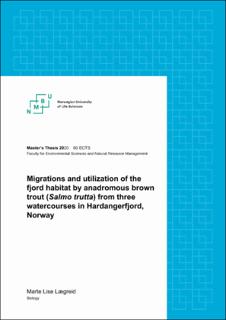| dc.description.abstract | The marine survival of the brown trout (Salmo trutta) seems to be reduced in western and middle regions of Norway, likely as a consequence of an excess abundance of the ectoparasite salmon lice (Lepeophtheirus salmonis), climate change and reduced abundance of food. The Norwegian traffic light system for capacity adjustments of fish farming came into force in October 2017, and the work of including the anadromous brown trout into the same system started in 2019. However, several knowledge gaps exist; life history, population status, migratory route and behavior, and general knowledge about how the salmon lice affects the populations of brown trout. The aim of my thesis was to compare the use of the Hardangerfjord by 125 brown trout from the Rivers Eio, Granvinselva and Oselva (located from inner-to-outer fjord in this order), by using acoustic telemetry. The results showed that the estimated biweekly survival in fresh water was generally high for tagged brown trout from all three populations. The estimated bi-weekly likelihood of migrating from fresh water to the near fjord-zone was higher for the Os brown trout compared to the Eio and Granvin brown trout. Fewer of the Granvin brown trout individuals were migratory (55%), but those who were, migrated early and far. The time of migration to the respective river mouths happened within the same time span for all three populations, with the Eio population portraying the broadest time period of migration from April 14th to June 29th. Os had the narrowest migration time span in the study (April 12th to May 26th), and the migration seemed to be more coordinated among the individuals compared to the Eio and Granvin individuals. Water flow and day of year were favored additive predictors by model selection for the estimated migration to the river mouth in Eio and Granvin, while temperature and daily change in water level was favored in Os. The arrival time in the different areas of the Hardangerfjord was observed to vary among the three populations. The maximum distance travelled (on average 11.3 km) was not size dependent and did not vary among the three populations. In general, the residence time in the middle parts of the Hardangerfjord was observed to be short (< 12 days on average) for all three populations. The Eio brown trout utilized the inner middle zones of the Hardangerfjord the most (on average approximately 56 days), while the Granvin brown trout used on average approximately 30 days in the inner part of Bjørnafjord. Brown trout from Os spent the least amount of time in fresh water in this study (on average approximately 44 days). Migratory brown trout from Os had the highest fraction of time spent in the estuary (approximately 34.7%), compared to the migratory brown trout from Eio that spent the least percentage of time in their respective estuary (approx. 31.2%). It was estimated that the largest individuals by length (> 24 cm) from Os and Eio spent more time in their respective estuary compared to smaller individuals (< 19 cm). However, the smallest individuals from Granvin spent more time in their respective estuary compared to larger individuals, and compared to time spent in the estuary by smaller fish from Eio and Os.
In conclusion the results provided in this study indicate that there is a difference in fjord use among the three studied populations, and that the brown trout population in Os seems to be the most affected study area by salmon lice. However, further research over several years is needed to gather concrete knowledge about the wild anadromous brown trout stock in order to better evaluate preservative measures in the Hardangerfjord and Bjørnafjord system. | en_US |

